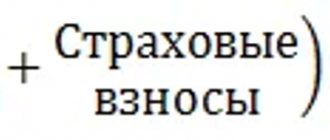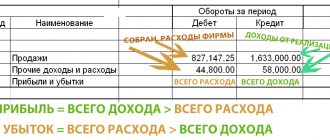Federal laws No. 401-FZ and No. 405-FZ dated November 30, 2016 amended Article 266 of the Tax Code of the Russian Federation, which regulates the procedure for creating reserves for doubtful debts. Starting from 2021, the amount of doubtful accounts receivable in relation to each counterparty should be determined minus accounts payable to this counterparty, and the maximum amount of the reserve at the end of the reporting period should be calculated as the greater of two values: 10% of revenue for the given reporting period or for the previous year *. 1C experts spoke about how these changes are supported in the 1C: Accounting 8 program (rev. 3.0), BUKH.1C.
Note:
* For other changes to income tax from 2021, read the article “Income Tax 2021: New in creating reserves for doubtful debts and carrying forward losses.”
Doubtful debts and provisions for them
For a reliable financial reflection of the organization’s receivables in the accounting documents, a so-called reserve for doubtful debts is created. To define this concept, you first need to understand what doubtful debt is.
doubtful if they are unlikely to be repaid in full, as evidenced by the following factors:
- violation by a partner of deadlines for paying off debt;
- obtaining information about serious financial difficulties of the debtor partner;
- absence of any additional guarantees (collateral, deposit, surety, bank guarantee, retention of any property of the counterparty, etc.)
FOR YOUR INFORMATION! Debt reflected in the debit of any accounting accounts, including 60, 62, 72, as well as issued as a loan under subaccount 58-3, may become doubtful.
Doubtful debts are identified based on the results of the inventory of current accounts:
- on loans;
- for goods and/or services sold;
- payment for work performed;
- in some cases - for advances issued to suppliers.
How to use the reserve for doubtful debts ?
In order to correctly reflect this type of debt on the balance sheet, a special type of reserve is created, which is intended to serve as an estimate for accounting. This means that the amount of debt must be reflected in the balance sheet by subtracting from it the funds allocated to the reserve. The content of expenses or income must necessarily display:
- creation of such a reserve;
- its increase;
- reduction of funds.
NOTE! The reserve created for doubtful debts is included in the expenses that are deducted for taxation, therefore, it is financially beneficial for organizations from the point of view of tax accounting to form and take into account the reserve.
Restoring the reserve amount
In February 2021, a contract for the supply of flower products was concluded between JSC Crocus and LLC Ficus. According to the agreement, “Crocus” ships “Ficus” a batch of Dutch tulips in the amount of 84,340 rubles, payment for which must be received within 18 days after shipment. On 02/04/2016, tulips arrived at the Ficus warehouse (full batch). Payment was not received from Ficus by February 23, 2016, and therefore a reserve was formed. The debt was repaid on 02/28/14, the reserve was restored.
Operations to form and restore the reserve on Crocus’ balance sheet were carried out as follows:
| Debit | Credit | Operation description | Sum | A document base |
| 91.2 | 63 | Reflects the amount of the reserve formed for the debt of “Ficus” due to the violation of the deadline for payment under the contract for flower products | RUR 84,340 | Minutes of the board's decision, accounting certificate-calculation |
| 63 | 91.1 | The amount of the reserve for the debts of “Ficus” was restored due to the latter’s repayment of debt under the contract for the supply of flower products | RUR 84,340 | Bank statement, accounting statement, supply agreement |
Legislative documents
State regulation of issues related to the reserve for doubtful debts is regulated by the following legislative acts:
- Tax Code of the Russian Federation (Part 2) dated August 5, 2000 No. 117-FZ, as amended, entered into force on March 1, 2015;
- Regulations on maintaining accounting and financial statements in the Russian Federation, approved by Order of the Ministry of Finance of the Russian Federation dated July 29, 1998 No. 34n;
- Accounting Regulations PBU 4/99 “Accounting Statements of an Organization”, approved by Order of the Ministry of Finance of the Russian Federation dated July 6, 1999 No. 43n;
- Order of the Ministry of Finance dated June 13, 1995 No. 49 (as amended on November 8, 2010) “On approval of the Methodological Guidelines for the Inventory of Property and Financial Liabilities”;
- Accounting Regulation 21/2008 “Changes in estimated values”, approved by Order of the Ministry of Finance of the Russian Federation dated October 6, 2008 No. 106n.
In what cases is it necessary to restore the provision for doubtful debts in accounting?
How to create a reserve for doubtful debts
The specifics of creating and disposing of a reserve for doubtful debts are not clearly regulated by law. Organizations must independently develop appropriate provisions and consolidate them in internal regulations. In this case, it is necessary to take into account the generally accepted features of the regulation of a company’s financial reserves.
- Basis for creation - for this type of reserve they will be the results of the inventory of receivables carried out on the last reporting day.
- The amount of reserve contributions is determined separately for each defaulter (analytical accounting of doubtful debts). At the same time, the solvency of each partner is taken into account (real financial prospects and opportunities for full or partial repayment of debt).
- Method for creating a reserve can be chosen by the organization independently based on the specifics of its activities and the nuances of the debt itself. There are three possible ways to create a reserve fund for doubtful debts:
- interval - the amount of reserve contributions is calculated every billing period (month, quarter) by calculating a percentage of the debt amount, which may vary depending on the degree of delay in payment;
- expert - the amount of debt that will not be paid on time is assessed separately for each debtor, this will be the amount of reserve contributions;
- statistical – data on bad debts is taken into account for several reporting periods for different types of debt.
IMPORTANT INFORMATION! The organization must record the chosen method and features of calculation in its accounting policies. For each type, you need to specify the appropriate conditions. For example, for the interval method, the accounting period and the percentage of deductions must be indicated (not necessarily the same as that used in tax accounting); for an expert – criteria for the debtor’s solvency, etc.
Accounting for reserves – accounting or tax?
The features of creating a reserve for doubtful debts in accounting and tax accounting differ significantly, since these types of accounting have different purposes. Let's compare the rules specific to accounting and tax accounting regarding the reserve.
- Mandatory creation. In accounting, such a reserve is required, since it is required by paragraph. 1 clause 7 of the Accounting Regulations. If an organization uses the accrual method for tax accounting, then the accountant himself decides whether to create such a reserve for tax accounting or not (this right is reflected in clause 3 of Article 266 of the Tax Code of the Russian Federation).
- Characteristics of deductions. Accounting defines reserve contributions as “other expenses,” and for tax accounting they must be taken into account among non-operating expenses.
- Interpretation of the doubtfulness of debt. For accounting purposes, any debt that is not repaid on time or in full is eligible for compensation as a reserve, but for tax purposes, only late payment for goods, services, and work can be recognized as such.
- Determining the amount of deductions . For accounting, the priority of establishing the size remains with the accountant (taking into account the characteristics of the debt), and for tax accounting the sizes are clearly defined by the Tax Code of the Russian Federation.
- The total size of the reserve fund . In accounting it is not limited, and in tax accounting it cannot be more than one tenth of revenue.
Do provisions for doubtful debts count as estimated liabilities ?
Conditions for the formation of the reserve
The decrees, orders and letters of the Ministry of Finance of the Russian Federation define a number of conditions necessary to comply with when creating a reserve fund for doubtful debts.
- This fund can be created as a result of settlements with legal entities and individuals - buyers for purchased goods, services or paid work. Advances paid to suppliers are not included in reserve amounts.
- After creating a reserve, the management and/or accounting department of the organization must constantly monitor the dynamics of debts, since their status may change, and the reserve fund must reflect the actual state of affairs (analytical approach).
- In accounting, a debt can be recognized as uncollectible according to the regulations of Art. 266 of the Tax Code of the Russian Federation (as for tax accounting). Otherwise, there is no limit on the timing and size of the reserve fund for debts.
- If the question arises about which accounting procedure to apply for reserve assets, accounting or tax, you should be guided by the following factors:
- if the discrepancies relate to a temporary difference in the correlation of debt terms (for accounting this is a complete non-repayment within 45 days after the expiration of time restrictions), then the difference will lead to the deposition of tax assets, that is, deductible time intervals for certain amounts of funds (clause 8, 11, 14 PBU 18/02, approved by Order of the Ministry of Finance of the Russian Federation dated November 19, 2002 No. 114n);
- if the amount of deductions to the reserve fund for accounting exceeds the 10% barrier established by tax accounting, then the company will operate with permanent financial differences (clauses 4, 7 of PBU 18/02, approved by Order of the Ministry of Finance of the Russian Federation dated November 19, 2002 No. 114n).
How is the inventory of the reserve for doubtful debts ?
Basic rules for reserve accounting
To account for the reserve for doubtful debts, the Chart of Accounts (order of the Ministry of Finance of the Russian Federation dated October 31, 2000 No. 94n) provides for account 63. Analytics on it should be carried out separately for each debt (clause 70 of the regulations on accounting and accounting). Accounting for the reserve in a separate account is due to the requirement of clause 6.7 of PBU 9/99 (Order of the Ministry of Finance of Russia dated May 6, 1999 No. 32n) to reflect sales revenue in its entirety in accounting, regardless of the fact of creating a reserve for it.
Since the reserve for doubtful debts refers to the values of the estimated value (clause 3 of PBU 21/2008, approved by order of the Ministry of Finance of Russia dated October 6, 2008 No. 106n), if the factors influencing its size change, the amount of the reserve changes (clause 2 of PBU 21/ 2008). Moreover, this change can affect both the data of the current period and the data of future periods (clause 4 of PBU 21/2008).
The unused part of the reserve may exist no longer than until the end of the year following the year of its creation (clause 70 of the regulations on accounting and accounting), which does not prevent the creation of a new reserve for the same debt.
Operations of creating, changing, writing off (restoring) the reserve are accounted for through other income (expenses), i.e. in the correspondence of account 63 with account 91. This is indicated in the following documents:
- in the regulations on accounting and accounting (clause 70);
- PBU 10/99, approved by order of the Ministry of Finance of Russia dated May 6, 1999 No. 33n (clause 11);
- PBU 21/2008 (clause 4).
But using the reserve for the purpose for which it was created (writing off a bad debt) will create a posting in the correspondence of account 63 with the account for writing off bad debts (clause 77 of the regulations on accounting and accounting).
For the procedure for writing off bad receivables, as well as sample documents, see the Typical Situation from ConsultantPlus. Get a free trial and proceed to the calculation example.
How to write off bad debts in accounting, see the material “Writing off accounts receivable and accounting entries.”
For a reserve formed for a debt denominated in a foreign currency, on the dates of transactions with this debt and on the dates of reporting, it will be necessary to recalculate not only the debt, but also the reserve on it at the exchange rate established for the corresponding day (clause 7 of PBU 3 /2006, approved by order of the Ministry of Finance of Russia dated November 27, 2006 No. 154n).
Reflection of the provision for doubtful debts in accounting
Since contributions to this reserve are the dynamics of the estimated value, they must be reflected on the balance sheet at a certain frequency. They are included in the expenses of the period in which changes in the movement of assets in this reserve were observed. Therefore, data on the state of the reserve must be contained in each accounting report (Article 15 of the Federal Law of December 6, 2011 No. 402).
We carry out accounting
Provisions for doubtful debts should be reflected in debit 91 “Other income and expenses” and credit 63 “Provisions for doubtful debts”.
We carry out bad debt
If a debt that was previously listed as doubtful is recognized as uncollectible, its reserve will be written off in debit 63 “Provisions for doubtful debts,” which corresponds with account 62 “Settlements with buyers and customers” or 76 “settlements with various debtors and creditors.” If the amount of bad debt is greater than the reserve for it, it will have to be written off as debit 91 “Other expenses and income.” If a debt has been written off for which the statute of limitations has expired, it must be kept for 5 years in off-balance sheet account 007 “Debt of insolvent creditors written off at a loss” in case the debtor’s solvency returns and the possibility of repayment becomes available.
We make partial payment
If payment is received from the debtor for doubtful debts with the formed reserve, at least partially, this affects the dynamics of funds in the reserve in a positive direction, which must be reflected as a recovery in debit 63 “Provisions for doubtful debts”, correspondence with account 91 “Other income and expenses."
We carry out the unused reserve
If the reserve could not be used before the end of the accounting year that follows the one in which the reserve was created, then this amount on the balance sheet should be added to the financial results for this year under debit 63 “Provisions for doubtful debts”, credit 91 “Other” income and expenses".
Posted as tax obligations
If only mandatory accounting of reserves is carried out, and tax accounting is not carried out, then permanent taxable differences must be recognized as tax liabilities, reflecting them in debit 99 “Profits and losses” and credit 68 “Calculations for taxes and fees”.
Examples
EXAMPLE 1 . Based on the results of the quarterly inventory, the organization revealed doubtful debts in the amount of 12 thousand rubles. according to payments for goods sold. A reserve of 100% was created for this debt. On the date the reserve is created, the accounting records will contain the following entry:
- debit 91-2, credit 63 – 12,000 rub. – a reserve for doubtful debt has been created.
After some time, the debtor company repaid part of this receivable in the amount of 7 thousand rubles. The posting on the date of deposit will be as follows:
- debit 63, credit 91-1 – 7,000 rubles. – the provision for repaid receivables was restored.
EXAMPLE 2 . The organization previously recognized a doubtful debt in the amount of 10,000 rubles. A reserve of 7 thousand rubles was created for it, which was then replenished to 100% of the debt amount. After the expiration of the statute of limitations, this debt was recognized as uncollectible and written off at a loss. Let's look at the transactions (each for its own date of a particular operation):
- debit 91-2, credit 63 – 7,000 rub. – a reserve for doubtful debt has been created;
- debit 91-2, credit 63 – 3,000 rub. – additional provision for doubtful debt has been accrued;
- debit 63, credit 76 – 10,000 rub. – bad debts are written off against the reserve.
Reflected in the balance sheet
To reflect doubtful debts in the balance sheet, line 1230 is intended. It reflects the amount of debts minus the reserve created for them.
Creation or additional accruals to the reserve take place on line 2350 of the financial report (“Other expenses”).
Separately, the balance on account 63 “Provisions for doubtful debts” is not displayed in the balance sheet; the total amount of accounts receivable is simply reduced accordingly.
Determination of the maximum amount of reserves before and after 2017
Let's look at how "1C: Accounting 8" edition 3.0 reflects operations on the formation of reserves for doubtful debts, taking into account the latest changes in tax legislation.
Example 1
| The organization Perspektiva LLC (contractor) entered into an agreement with Delta LLC (customer) for the provision of services. The agreement establishes a payment period for services rendered - no later than 5 days from the date of signing the act of provision, applies the general taxation system, the provisions of PBU 18/02, and pays VAT. The accounting policy of Perspektiva LLC for profit tax purposes provides for the formation of reserves for doubtful debts. In both accounting and tax accounting, reserves are calculated at the end of each quarter. On November 2, 2015, services were provided to the customer in the amount of RUB 150,000. (including VAT 18%), the act was signed on the same day. Payment was not received from the buyer within the established period. Proceeds from sales of Perspektiva LLC, taken into account for profit tax purposes, amounted to:
|
Before starting work, the user must configure the accounting policies and tax accounting parameters. For the example under consideration, in the contract card with the customer, it is necessary to indicate the payment period under the contract, as shown in Figure 1.
To reflect sales transactions in the 1C:Accounting 8 program, edition 3.0, the standard accounting system document Sales (act, invoice) (Sales section) with the type of transaction Services is used.
In order for the buyer's debt to be automatically included in the calculation of reserves, in the Settlements form (accessed via the hyperlink of the same name from the sales document form), the Account of settlements with counterparty attribute must take the value 62.01 or 76.06.
As of November 30, 2015, doubtful debt amounts to RUB 150,000.00, but its period of occurrence does not exceed 45 calendar days. Therefore, the routine operation Calculation of reserves for doubtful debts for November does not make any movements in the registers. The indicator Provisions for debts in the information register of the Share of write-off of indirect expenses is also not calculated.
But as of December 31, 2015, the debt period is already in the range from 45 to 90 calendar days, therefore, when performing the operation Calculation of reserves for doubtful debts for December, the reserve is calculated and the accounting entry is generated:
Debit 91.02 Credit 63 - for the amount of the reserve, the value of which is RUB 75,000.00. (RUB 150,000.00 x 50%).
For tax accounting purposes for income tax, amounts are entered into special resources of the accounting register:
Amount NU Dt 91.02 and Amount NU Kt 63 - for the amount of the reserve, taking into account the limitation, the value of which is RUB 70,000.00. (700,000.00 x 10%); Amount PR Dt 91.02 and Amount PR Kt 63 - for a constant difference, the value of which is RUB 5,000.00. (RUB 75,000.00 – 70,000.00).
The document Regular transaction with the type of operation Calculation of reserves for doubtful debts, in addition to movements in accounting and tax accounting, also creates an entry in the periodic register of information Calculation of reserves for doubtful debts, reflecting information about doubtful debts and accrued reserves in accounting and for profit tax purposes.
To document the calculation of the accrual and adjustment of the reserve for doubtful debts, you need to generate a statement of calculation for the routine operation.
It can be done:
- from the context menu of the routine operation Calculation of provisions for doubtful debts;
- Click the Help-calculation button from the Month Closing processing form;
- from the Operations section -> Closing the period by clicking on the References-calculations hyperlink and selecting the Provisions for doubtful debts option.
The Certificate-Calculation of Provisions for Doubtful Debts report can be generated by separately displaying accounting indicators, tax accounting indicators or accounting indicators with permanent and temporary differences (Fig. 3). Indicators are selected in the report settings, which can be accessed by clicking the Show settings button.
Rice. 3. Certificates of calculations of reserves for doubtful debts
Please note that in the Certificate of calculation of reserves for doubtful debts according to tax accounting data, column 4 reflects the share of recognition of expenses taking into account the standard, which is calculated when performing the regulatory operation Calculation of shares of write-off of indirect expenses and is recorded in the indicator Provisions for debts of the information register Shares of write-off of indirect expenses.
When performing the routine operation Calculation of income tax for December, which is included in the Closing of the month processing, a permanent difference leads to the recognition of a permanent tax liability in the amount of RUB 1,000.00.
In the income tax return for 2015 (approved by order of the Federal Tax Service of Russia dated November 26, 2014 No. ММВ-7-3 / [email protected] ), the amount of contributions to the reserve (RUB 70,000.00) is reflected in the total amount of non-operating expenses for line 200 of Appendix No. 2 to Sheet 02.
2021 is coming. As of March 31, 2016, the debt period already exceeds 90 calendar days, so the amount of the reserve is determined as 100% of the amount of doubtful debt and amounts to RUB 150,000.00. This means that in accounting the reserve must be adjusted upward.
In tax accounting, the maximum amount of contributions to the reserve is already calculated based on 2021 revenue, therefore, the amount of the reserve, taking into account the limitation, should not exceed RUB 25,000.00. (RUB 250,000.00 x 10%).
The previously accrued reserve must be adjusted downwards, and the difference is included in non-operating income.
Thus, in the first quarter the tax base increases by the amount of the restored reserve.
When performing the operation Calculation of provisions for doubtful debts for March, the following accounting entry is generated:
Debit 91.02 Credit 63 – for the amount of the increase in the reserve (RUB 75,000.00 = RUB 150,000.00 – RUB 75,000.00).
For tax accounting purposes for income tax, amounts are entered into special resources of the accounting register:
Amount NU Dt 63 and Amount NU Kt 91.01 - for the amount of the restored reserve (45,000.00 rubles = 70,000.00 - 25,000.00 rubles); Amount PR Dt 91.02 and Amount PR Kt 63 - for a constant difference (RUB 75,000.00); Amount PR Dt 63 and Amount PR Kt 91.01 - for a negative constant difference (- 45,000.00 rub.).
When performing the routine operation Calculation of income tax for March, which is included in the Closing of the month processing, permanent differences lead to the recognition of a permanent tax liability in the amount of RUB 24,000.00.
Until the end of 2021, the amount of the reserve in accounting remains unchanged (RUB 150,000.00). In tax accounting, the reserve is adjusted upward on a quarterly basis as revenue increases.
When performing the operation Calculation of provisions for doubtful debts for December 2021, the following accounting entry is generated:
Debit 63 Credit 91.01 - for the unspent amount of the reserve created last year and added to income (RUB 75,000.00); Debit 91.02 Credit 63 - for the amount of the reserve added to expenses (RUB 75,000.00).
For the purposes of tax accounting for income tax, amounts are entered into special resources of the accounting register (the reserve is accrued up to the maximum amount, permanent differences are reflected).
Thus, as of December 31, 2021, after performing the operation Calculation of reserves for doubtful debts, the amount of the reserve is:
- RUB 150,000.00 — in accounting;
- RUB 100,000.00 (RUB 1,000,000.00 x 10%) - in tax accounting.
In the income tax return for 2021 (approved by order of the Federal Tax Service of Russia dated October 19, 2016 No. ММВ-7-3 / [email protected] ), reserves for doubtful debts are reflected as follows:
- the amount of restored reserves (45,000.00) is reflected in the total amount of non-operating income on line 100 of Appendix No. 1 to Sheet 02 of the declaration;
- the amount of contributions to the reserve (RUB 75,000.00) is reflected in the total amount of non-operating expenses on line 200 of Appendix No. 2 to Sheet 02.
With the onset of 2021, the procedure for calculating the maximum reserve amount in tax accounting is changing. Since there is no revenue in the first quarter of 2017, the maximum amount of the reserve is determined as 10% of 2021 revenue.
Thus, the amount of the previously accrued reserve is not restored and remains RUB 100,000.00. In accounting, the reserve also does not change, so the routine operation Calculation of reserves for doubtful debts for March 2021 does not generate entries, but only makes an entry in the information register of the same name.
As can be seen from Example 1, the amendment introduced by Federal Law No. 405-FZ of November 30, 2016 to paragraph 4 of Article 266 of the Tax Code of the Russian Federation significantly improves the situation of the taxpayer, since during the reporting periods the taxpayer will not have to increase the tax base at the expense of restored reserves.
The right to tax accounting of reserves for doubtful debts
It is not necessary to reflect doubtful debts and provisions for them in tax accounting. But if the accounting department deems it necessary to do this, this right is ensured and regulated by Art. 266 Tax Code of the Russian Federation.
For tax purposes, the definition of doubtful and bad debt is no different from accounting purposes. We discussed the difference in detail above. The procedure for creating and changing the reserve for the following debts differs:
- if the debt period exceeds 3 months, then the amount of the reserve will be fully equivalent to the amount of the debt;
- if the debt payment is overdue for a period of 45 to 90 days, only half of the amount can be deposited into the reserve;
- Before the debt is 45 days overdue, changes to the reserve are not permitted.
For each doubtful debt, analytical records must be constantly maintained for a prompt response in the event of a change in the financial situation of the debtor.
NOTE! In tax accounting, the reserve for doubtful debts can be used exclusively to cover losses on written-off bad debts.
Provisions requiring reinforcement in accounting policies
Based on the list of issues that the organization will have to resolve independently regarding the creation of each of the reserves, reflection in the accounting policy will require:
- In terms of accounting:
- frequency of debt inventory;
- criteria for recognizing a debt as doubtful;
- signs of insolvency of the counterparty;
- criteria for assessing the probability of debt payment;
- rules for determining the size of the reserve formed.
- Regarding tax accounting:
- an indication of whether such a reserve will or will not be formed, while in relation to the formed reserve there is no need to describe other accounting issues, since in relation to them one will have to be guided by the rules of Art. 266 Tax Code of the Russian Federation;
- for the created reserve - the frequency of debt inventory.
At the same time, there is no need to indicate in the accounting policies that a reserve will be formed, since its creation is mandatory under certain conditions.








